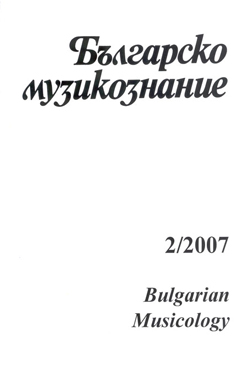Бревиарът от НБКМ - София. Някои наблюдения върху репертоара
The Breviary from the St. Cyril and Methodius National Library - Sofia. Some Observations on Repertoire
Author(s): Yavor GenovSubject(s): Music
Published by: Институт за изследване на изкуствата, Българска академия на науките
Summary/Abstract: The beginning of Holy Week and the Resurrection of Christ (Easter) is preceded by a preparatory period known as the “Great Fast” (i.e. Lent). It lasts for forty days, thus it is known as the “Chetiridesetnitsa” (from the Slavic chetirideset meaning “forty”), or by its Latin name, the Quadragesima. According to a number of scholars, this liturgical cycle took shape in the first centuries of Christianity and gained significance as an established liturgical series, whose focus was the four weeks preceding Palm Sunday. Each of the four Sundays that begins the weeks of fasting is associated with a well-developed and independent repertoire, grounded in the whole liturgical cycle. Observations based on different sources, some of date from relatively early periods (11th-12th centuries), indicate that it is possible to claim a certain stability in the repertoire of services of the Quadragesima. A handwritten Roman breviary dating from 1639 can be found in the collection of the St. Cyril and Methodius National Library in Sofia. It was created in the time of Pope Urban VIII (1623 - 1644), according to the standards established by the Council of Trent. The text on the title page reads: Antiphonale Romanum iuxta breviarium sacrosancti consilii Tridenti resitutum Pars Hyemalis. The contents of the book consist of a part of the liturgical calendar, namely the Quadragesima cycle, or more precisely, the four weeks of the series. The manuscript begins with the Saturday before the first Sunday of the Quadragesima, which besides the four Saturdays and Sundays includes the weekdays as well (the so-called feria). From the initial observations on the breviary that have been made so far, it can be generalized that it contains a relatively full documentation of the repertoire of the cycle. The goal of the present paper is to introduce the musical manuscript described above to the academic community. At the same time, a full list of the manuscript’s repertoire is provided. In order to be able to discuss the question of the extent to which the manuscript represents the stability of the services of the Quadragesima, parallels will be drawn with the previously-studied antiphonaries that make up the basic part of the Cantus Database project, in this way tracing the observed musical changes in the first two major responsories (the so-called responsorium prolixa ) from the morning service of the first Sunday of the Quadragesima.
Journal: Българско музикознание
- Issue Year: 2007
- Issue No: 2
- Page Range: 146-166
- Page Count: 21
- Language: Bulgarian
- Content File-PDF

